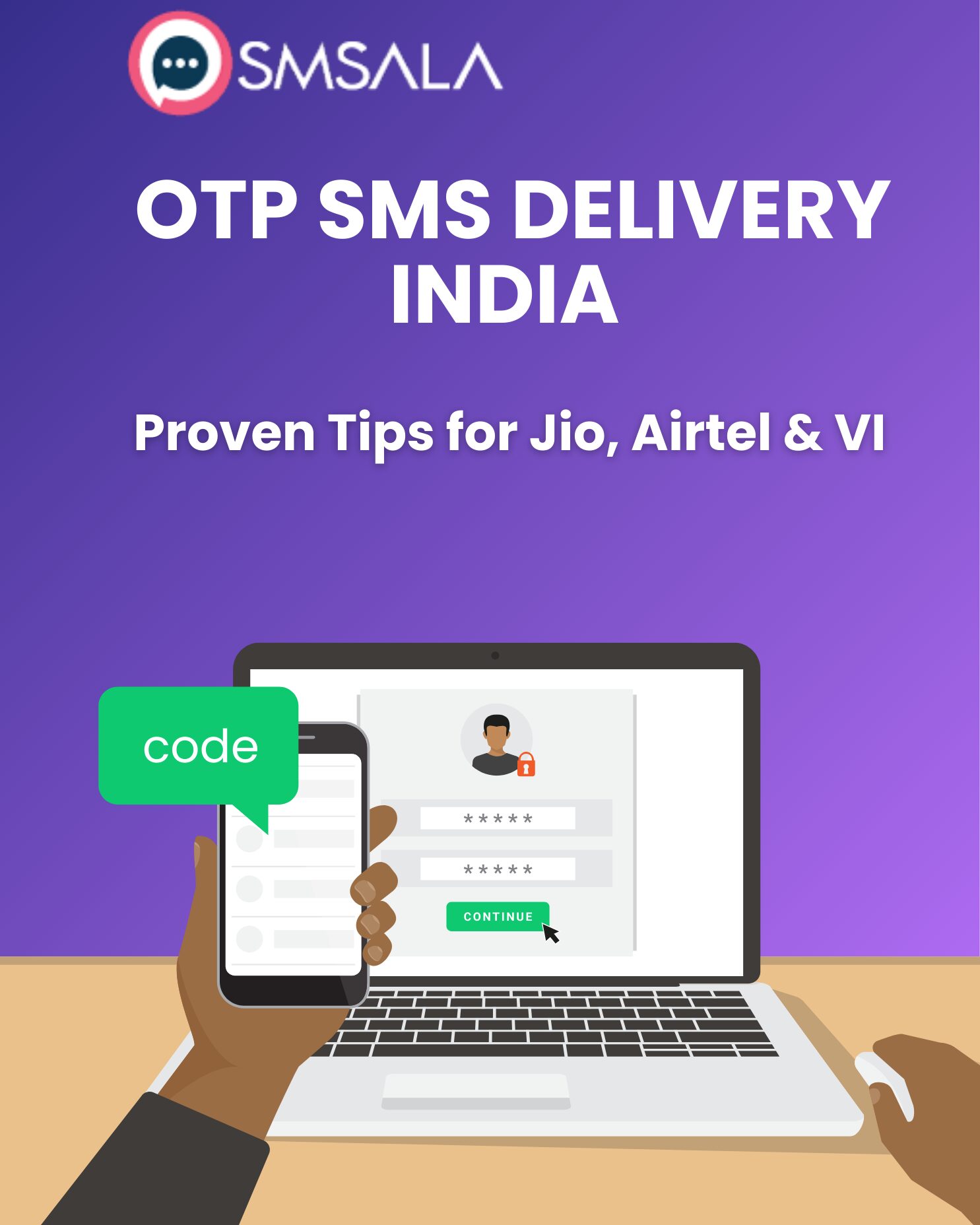Every second of delay can cost a customer when he/she is to logs in, resets a password, or makes a payment. A late OTP (One-Time Password) SMS can translate to a missed transaction and ultimately loss of a sale, or worse; loss of trust towards the brand. In case of companies in India, this is not just a technical issue with the need to deliver OTP SMS as fast and reliably as possible through the providers Jio, Airtel, and VI.

When a customer is waiting to log in, reset a password, or complete a payment, every second counts. A delayed OTP (One-Time Password) SMS can mean an abandoned transaction, a lost sale, or worse—eroded trust in the brand. For businesses operating in India, ensuring fast and reliable OTP SMS delivery through Jio, Airtel, and VI is not just a technical concern—it’s a business-critical requirement.
This article explores best practices for improving OTP SMS delivery in India, specifically focusing on the country’s three largest mobile carriers. Whether you’re a fintech startup, an e-commerce giant, or a SaaS platform, these insights will help you ensure your OTPs arrive quickly and consistently, keeping customers engaged and secure.
Why OTP SMS Delivery Matters in India
India has over 1.14 billion mobile connections, and SMS remains the backbone of digital authentication. Despite the growth of email and push notifications, SMS OTP continues to dominate for:
- Banking and Payments: UPI, net banking, card transactions.
- E-commerce: Cash-on-delivery verification and login security.
- Healthcare and Education: Secure access to portals and teleconsultations.
- Ride-hailing and Food Delivery: Driver/passenger verifications.
Unlike other channels, SMS doesn’t require internet access, making it universally accessible across India’s urban and rural regions. That universality is also why OTP sms delivery India is a top concern for brands that rely on real-time authentication.
Key Challenges with OTP SMS Delivery
Delivering OTP SMS in India isn’t as simple as hitting the send button. Several challenges affect timely delivery:
1. DLT (Distributed Ledger Technology) Compliance
Since 2021, TRAI (Telecom Regulatory Authority of India) mandates all enterprises and aggregators register their headers, templates, and content on DLT platforms. Non-compliance can cause messages to be blocked or delayed.
2. Carrier Network Congestion
Peak hours, like festive sales or UPI transaction surges, often lead to bottlenecks in SMS routing, especially with Jio, Airtel, and VI handling massive traffic simultaneously.
3. Spam Filters and Content Scrutiny
Carriers deploy filters to block promotional spam. OTP SMS occasionally gets flagged if the sender’s template isn’t properly registered.
4. Sender ID Mismatches
Messages sent with incorrect or unregistered sender IDs face rejection at the operator’s SMS gateway.
5. Latency Issues with Aggregators
Businesses relying on subpar SMS gateway providers often experience delays, as these providers may use cheaper but slower international routes.
Understanding the Role of Jio, Airtel, and VI
India’s OTP SMS ecosystem revolves around three key players:
- Reliance Jio – Largest user base, strong presence in rural regions, and growing dominance in urban centers.
- Bharti Airtel – Known for enterprise-grade network quality, handling a huge share of corporate messaging traffic.
- Vodafone Idea (VI) – Despite market challenges, still a critical player with millions of subscribers.
For businesses, optimizing OTP SMS delivery across all three is essential, because customers may be on any network. A single weak link can lead to delivery failures.
Best Practices for Improving OTP SMS Delivery in India
1.Ensure Full DLT Compliance
The foundation of smooth OTP delivery lies in DLT registration. To comply:
- Register as a Principal Entity (PE) on a DLT portal (such as Jio DLT, Airtel DLT, or VI DLT).
- Get your sender IDs (headers) approved. For OTP, use Transactional or Service Explicit routes.
- Pre-register message templates with exact wording to avoid mismatches.
For example, instead of writing:
“Your OTP is 458769. Do not share it with anyone.”
You must ensure this exact format matches your DLT-approved template. Even a misplaced period can cause rejections.
2. Use the Right SMS Route
Indian carriers differentiate between Transactional, Promotional, and Service routes:
- Transactional Route – Reserved for banks and financial institutions. OTPs from these routes are delivered 24/7.
- Service Explicit Route – For verified businesses sending OTPs, login codes, and important alerts.
- Promotional Route – Cheapest but not suitable for OTPs, as delivery is restricted to business hours and may face DND (Do Not Disturb) filters.
Choosing the wrong route is one of the top reasons for delayed OTP SMS delivery India.
3. Prioritize Redundancy with Multiple Aggregators
Think of SMS delivery like road traffic. If one highway is jammed, you need an alternate route. Partnering with multiple SMS aggregators ensures OTPs reroute automatically if one channel slows down.
For instance, if an Airtel subscriber doesn’t receive OTP within 3 seconds via Aggregator A, your system should retry through Aggregator B—reducing customer friction.
4. Optimize Message Content for Speed and Compliance
OTP messages should be short, clear, and aligned with registered templates. Avoid unnecessary branding or promotional add-ons.
Bad Example:
“Welcome to XYZ App! We’re excited you joined. Use OTP 739201 to log in. Also, check our festive sale…”
Good Example:
“OTP for XYZ login: 739201. Valid for 5 minutes. Do not share.”
This ensures faster delivery, avoids content filtering, and keeps customers focused.
5. Monitor Delivery Reports (DLRs) in Real-Time
Delivery Reports aren’t just receipts—they’re diagnostic tools. By monitoring per-carrier delivery success rates, you can identify if Jio users face higher delays than Airtel, and adjust routing accordingly.
Modern SMS APIs allow real-time dashboards where businesses can track:
- Average Delivery Time (per operator)
- Failure Reasons (Spam filter, Invalid header, DND block)
- Retry Success Rates
6. Implement Intelligent Retries
A well-designed system doesn’t just send an OTP once. If delivery fails, it retries with intelligent intervals:
- Retry within 3 seconds via same aggregator.
- If still undelivered, switch carrier route within 10 seconds.
- If SMS fails completely, fallback to voice OTP or WhatsApp OTP.
This layered approach guarantees the customer always gets the code.
7. Choose Aggregators with Direct Operator Connections
Not all SMS gateway providers are equal. Some rely on international grey routes that add delays. For OTPs in India, select aggregators with direct operator connectivity with Jio, Airtel, and VI.
Direct connectivity ensures:
- Lower latency (sub-5-second delivery)
- Higher throughput during peak hours
- More reliable DLRs
8. Leverage Sender ID Whitelisting
Whitelisted sender IDs deliver more reliably because they are trusted by operators. For example, banks often use fixed sender IDs like “HDFCBK”. Businesses should also maintain consistent IDs across all DLT portals.
9. Optimize Retry Logic for Peak Hours
During festive sales like Diwali or major UPI spikes, OTP traffic can surge by 5–10x. Pre-configured retry logic ensures your OTPs don’t get stuck behind promotional traffic.
Some enterprises implement priority queues, where OTP traffic bypasses marketing messages in the system.
10. Diversify with Multi-Channel OTP Delivery
While SMS remains primary, offering voice OTP, email OTP, or WhatsApp OTP as fallbacks improves overall reliability. For example:
- A Jio user with weak network may miss the SMS but receive a WhatsApp OTP instantly.
- An Airtel subscriber traveling abroad may get email faster than SMS.
This multi-channel redundancy reduces failed logins and enhances user trust.
Real-World Example: OTP Failures During Festive Sales
In 2022, several e-commerce platforms in India faced OTP delivery failures during Diwali mega-sales. Customers reported delays of 10–15 minutes, causing abandoned checkouts.
Post-analysis revealed:
- Heavy congestion at Airtel SMS gateways.
- OTPs routed via single aggregator with no redundancy.
- Templates rejected due to minor mismatches on DLT.
Companies that had implemented multi-aggregator routing and strict DLT compliance reported minimal impact, highlighting the importance of proactive planning.
The Role of DLT in Shaping OTP SMS Delivery
DLT isn’t just a compliance checkbox—it directly impacts OTP delivery efficiency. By ensuring:
- Template accuracy – reduces rejection.
- Header consistency – ensures legitimacy.
- Traceability – carriers can quickly identify fraudulent senders.
For businesses, strict DLT adherence equals faster approvals and fewer blocked messages.
Future of OTP SMS Delivery in India
While SMS OTP remains dominant, trends are shifting:
- WhatsApp OTP adoption is rising, especially among fintech and e-commerce players.
- RCS (Rich Communication Services) promises richer, more interactive authentication.
- Biometric authentication is slowly reducing reliance on OTPs in high-security sectors.
Still, given India’s diverse telecom ecosystem, SMS OTP will remain a cornerstone for at least the next 5–7 years.
Conclusion
Improving OTP SMS delivery in India requires a blend of regulatory compliance, technical redundancy, and smart routing. By aligning with Jio, Airtel, and VI’s requirements, businesses can significantly cut down delivery delays and failures.
The key takeaways include:
- Register and strictly comply with DLT guidelines.
- Use transactional/service routes for OTPs.
- Partner with multiple aggregators with direct operator connectivity.
- Monitor DLRs and implement intelligent retry mechanisms.
- Diversify delivery channels with voice and WhatsApp OTPs.
When implemented together, these practices ensure customers receive OTPs instantly, safeguarding user experience and business reputation.


